Have you ever imagined building a reef tank in your home? If so you must add these Green star polyps or GSP into your aquarium. It is a great starter animal for beginners who like to create a reef aquarium. I must say they are fast-growing and very easy to care for. This wonderful coral variety creates a fascinating view of your reef aquarium. I prepare this guide so you can know everything about how to grow green star polyps coral and how to care for them.

What are Green star polyps?
Jump To
- 1 What are Green star polyps?
- 2 How much is a green star polyp cost
- 3 One look Care guide for Green star polyps
- 4 Appearance
- 5 Tank requirements for green star polyps
- 6 How to place them in a tank
- 7 How to frag or propagate them
- 8 How fast do green star polyps grow?
- 9 What do green star polyps eat
- 10 Tank mates
- 11 Predators of green star polyps
- 12 Why are green star polyps dying?
- 13 Related topics
Green star polyps (Pachyclavularia violacea) is a soft coral species that grows in the shallow tropical water of the ocean. These are native to the Indo-pacific region including the Great Barrier Reef, Fiji, Tonga, and the Solomon Islands. Star polyps are found in up to 62 feet and inhabit lagoon areas and coral reefs. The soft and flexible structures are situated around the mouth of polyps. Those are called tentacles. Star polyps have eight bright fluorescent green color retractable soft tentacles.
Moreover, yellow or white bands situate around the outside of the central oral disk. They can grow around two inches in diameter and are relatively larger than their cousin species. They take required nutrition from the water column and also produce required compounds using photosynthesis. Thus, star polyps need lightning in captivity but need not a lot of light to grow. Moreover, GSP have an extremely tolerant range of water conditions.
How much is a green star polyp cost
One look Care guide for Green star polyps
| Scientific name | Pachyclavularia violacea |
| Common name | Green star polyps, GSP, Star polyps, StarBurst polyp, Daisy polyps, Purple Mat polyps, Starburst polyps, Eight Tentacle Polyp |
| Care level | Easy / Beginner |
| Native to | Fiji, Tonga, Solomon Islands, and the Great Barrier Reef, easily aquaculture (Indo- pacific region) |
| Type (soft or hard coral) | Soft |
| Color | Fluorescent Green, Dark green, yellow, Brown polypswhite center, purple mat |
| Tank size | Minimum 5 gallon (20 liters) |
| Preferred temperature | 78-82 degrees Fahrenheit (25.5-27.8oC) |
| Preferred salinity | Measured as specific gravity 1.025 |
| Preferred pH | 8.2- 8.5 |
| Alkalinity | 8-12 dKH |
| Salinity | 1.025 – measured as specific gravity (35ppt) |
| Ammonia, nitrates, and nitrites level | 0 |
| Lighting | Any (avoid high intensity light) |
| Growth rate | Fast |
| Temperament | Peaceful, but it will try to grow over everything in reach |
| Recommended tank mates | Clown fish, Basslets, Fire fish, Blennies, Mandarin gobies, Cardinal fish, Starfish, Pygmy angelfish, larger damsel fish |
| Preferred food | Filter feeders and they take dissolved organic matters,Thus, do not need any special feed. Moreover, Zooxanthellae produce energy by photosynthesis. |
| Feeding frequency | One or two times per week with special feed |
| Propagation by | Asexual, using small fragments |
| Known Predators | Puffers, triggers & general coral pests. |
Appearance
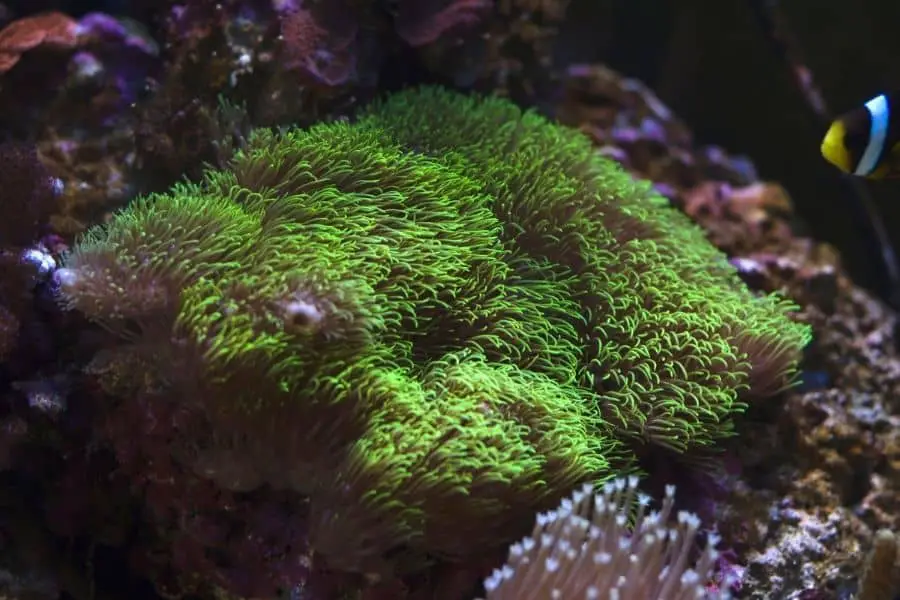
Green star polyps have eight tentacles and these tentacles are extremely soft. The amazing thing is, this tentacle surrounds a star-shaped mouth (open). When considering their size, they have half an inch (0.5 inches or 1.3 cm) diameter. Further, GSP colonies can grow out around one foot (0.3m) in size. If you think about why I selected GSP to decorate my aquarium, definitely, the following reasons will solve your doubt.
- Easy to care
- Fast-growing variety
- Easy to propagate
- Tolerant of a range of water conditions
- Inexpensive
- Give dramatically beauty to the aquarium
Further, GSP have the ability to give attraction to your aquarium through four colors. Because they are in 4 different colors. Those are fluorescent green, dark green, yellow and brown. According to your preference and aquascaping type, you can select a suitable color for your aquarium.
Tank requirements for green star polyps
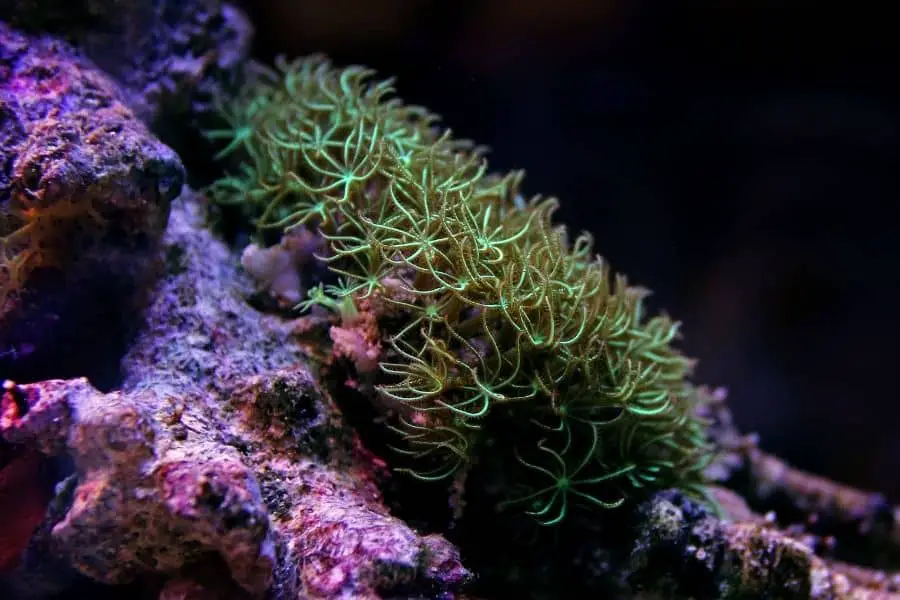
Starburst polyp can survive in a wide range of water conditions.
Size of the tank
They do not need large tanks to grow up. The minimum tank requirement for GSP is 5 gallons (20 liters). You can use large tanks that exceed their minimum requirement.
Water quality
Water quality is a general term that is used to recognize some collective parameters such as pH level of water, hardness level, temperature, salinity level, and nitrate, phosphate level, and mineral level. Here are some important water quality measurements required for green star polyps.
Salinity level
First, you need to prepare saline water that suits your coral and other saltwater fish. The ideal salinity level is 35 ppt (1.025 specific gravity) and you can easily make it at home. Take portable fresh water and add 33 grams or 34 grams of aquarium salt per one gallon. You should calculate the salt amount that you require before adding them to your tank water.
As an example, if you have 10 gallon-tank, you should add 340 grams (35 * 10 gallon) of aquarium salt to the tank. You can measure water salinity using a pH meter. Otherwise, most of the aquarist use a hydrometer and measure specific gravity (SG) of the water to understand salinity level. If you use a hydrometer, special gravity should be in between 1.023 – 1.025.
Temperature range
Green star polyps inhabit tropical waters in the wild. Thus, they like to live in warm water conditions. Hence, provide 72-82 Fahrenheit temperature to them. You can use an aquarium heater to maintain the constant temperature in your saltwater tank
pH range
They also prefer alkaline water. The pH of the aquarium water should be in between 8.0-8.24.
Water Hardness
Water hardness should maintain between 8-9.5dKH.
Calcium and Magnesium level
It is important to have water with correct magnesium and calcium levels. The calcium level should be around 420-500ppm. Magnesium level must be in between 1250-1350 ppm. You can use “Automatic dosing equipment” to maintain Ca, Mg and Alkalinity at a constant level. It balances these parameters of your tank automatically. It is easy for you.
Nitrates and Phosphate level
Green star coral polyps can survive in the water that has nitrates and phosphates below 10 ppm. If it increases, GSP cannot survive in that water. Therefore, you should maintain these levels below 10 ppm. Change and replace 30% of tank water per week to overcome this issue. Use water that has a 35ppt salinity level to replace the tank water. The phosphate level should be at zero.
Flow rate
In the wild, unlike other coral varieties, GSP prefer moderate to high water flows. Thus, they inhabit reef flats and inshore reefs where ocean currents are strong and high. Hence, you should provide good water flow in your aquarium or make artificial currents using an artificial tide maker. The continuous water flow is a good source of nutrients. Thus, they can easily filter the organic molecules dissolved in water.
Lighting
You need not provide any special lights to grow green star polyps. GSP prefers moderate lighting conditions. But they can survive in low light conditions too. Therefore, you can provide LED light, Kessil Tuna blue A80, or T5 lighting. More photosynthesis benefits, lights give an amazing look to GSP. Because they stress in this condition and not open properly.
How to place them in a tank
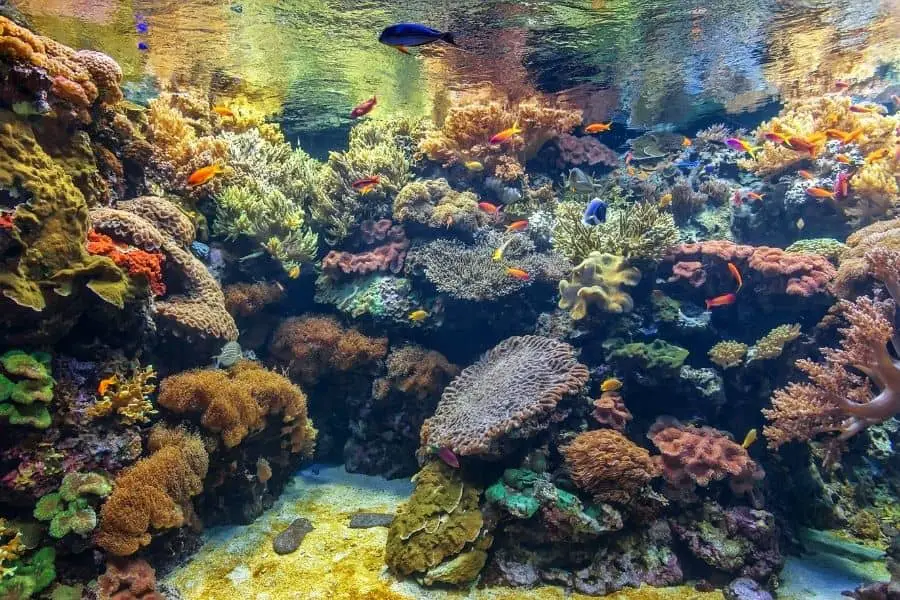
You have to consider several factors before putting GSP in your tank or aquarium. Green star polyps are fast-growing soft coral species. Thus, it can quickly spread out in the whole tank. Sometimes it will grow over your expensive and highly sensitive corals too. Then those expensive corals tend to die, because of a lack of nutrients, light, and space. Hence, placed GSP in a separate structure or separate stone system in the tank.
If not, you can grow GSP in the back glass of the aquarium. It will spread over the back glass and side glasses too. Therefore, as an aquarist, you can maintain the population of GSP. Further, GSP grows in sand substrates and spreads easily on sand. To limit the growth and propagation of GSP, you can use some aggressive corals such as Frogspawn, Torch Corals.
After it is added along the perimeter of GSP it will restrict the expansion of star polyps. You can add the Aiptasia-X line on the edge of the GSP. Then polyps do not grow beyond the direction of the Aiptasia-X line. But it is a temporary solution and you must repeat it systematically to control the GSP.
How to frag or propagate them
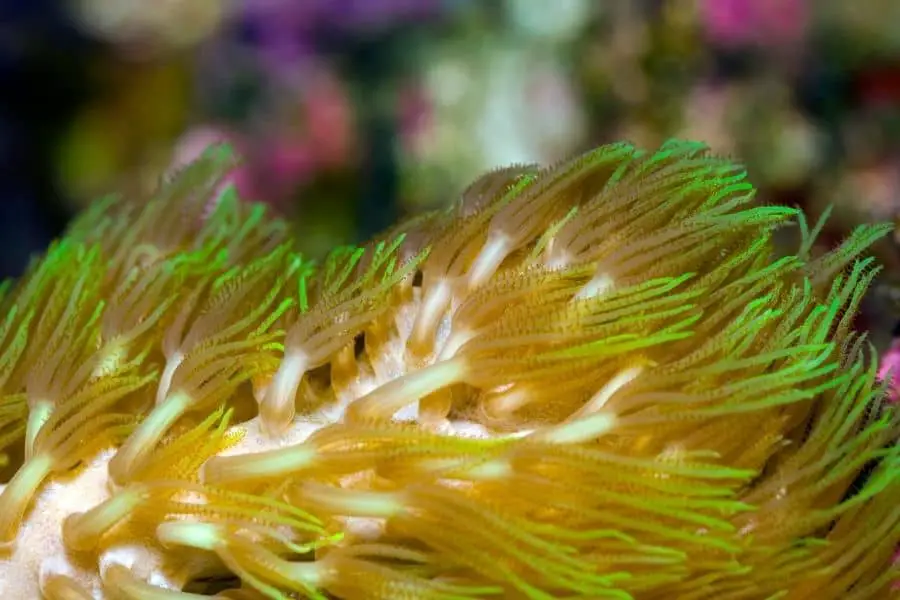
Green star polyps propagation is very easy. You can propagate GSP at home by going through the following methods.
First method
- Placed any substrate such as stone, brick, driftwood, or ornament near the Green star polyp colony
- Then GSP colony grow over that substrate
- The separate new colony that grows over the substrate using a sharp scalpel
- Placed new GSP colony in the new tank
Second Method
- Detach small part of Green star polyp colony
- Attach it in some substrate such as brick, stone, or driftwood
- Placed it in the saltwater aquarium and let them grow
How fast do green star polyps grow?
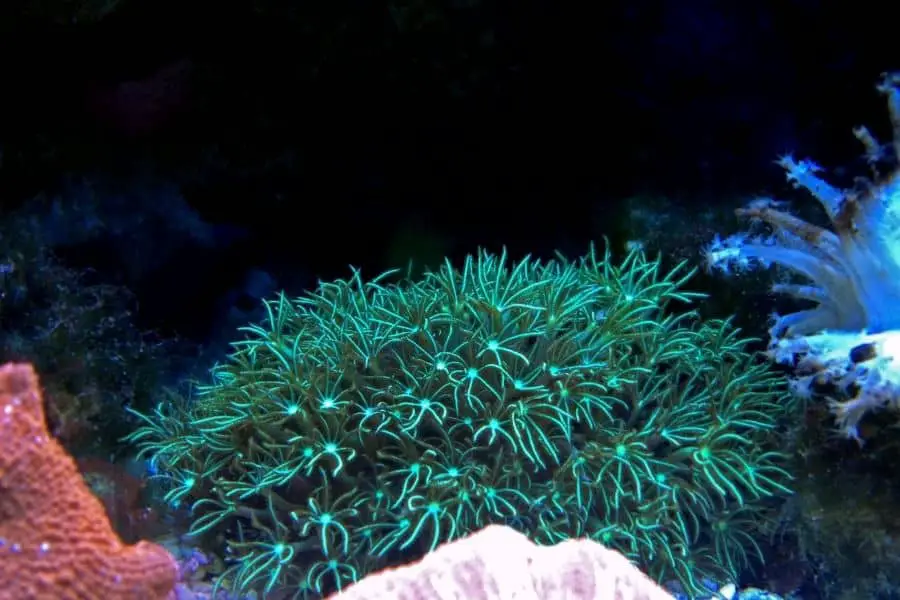
They grow incredibly fast and the green star polyps colony gives a beautiful grassy look to your aquarium. Several GSP can reach up to one inch in size within one month. The small colony of GSP can grow over the bottom of your tank like a grass carpet within several months. First, they spread their purple mat over the nearby hard surfaces. Hard surfaces can be hard coral, living rock, sand, or any other substrate. Thus, you should maintain them and cut and remove overgrowth particles.
What do green star polyps eat
They take required nutrients using two methods. Symbiotic algae hosted within GSP. Those algae are called zooxanthellae and they provide most nutrients by photosynthesis. Further, green star polyps are filter feeders and they take dissolved organic matters from the water as a nutrient. In the aquarium, they can grab part of their nutrient requirement by photosynthesis. Moreover, GSP can grab nutrients from fish foods that you add to the fish tank.
The oyster feast, Roti feast, Mini Mysis and Cyclopeeze can be used as GSP food. When you feed your fish, Star polyps trap small food particles. Moreover, you can provide good quality formulated food that is prepared for filter-feeding invertebrates. It is not essential. Because they can eat enough food by the above methods.
Tank mates
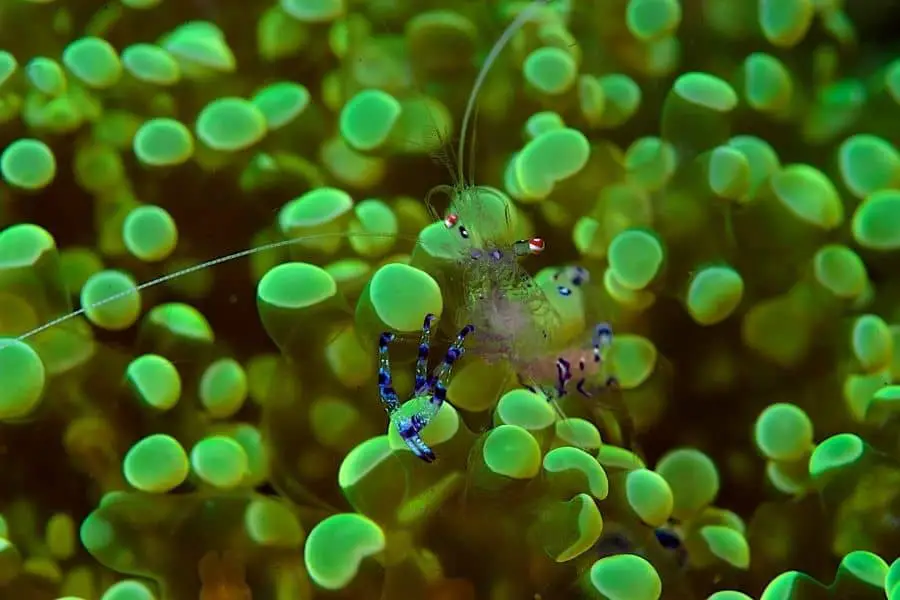
Green star polyps are peaceful coral species and they can do well with many Reef fish, Snails, Crabs, and Shrimp varieties. The fully reef safe fish are ideally matched to add in GSP aquariums.
Those are;
- Clownfish
- Basslets
- Firefish
- Blennies
- Mandarin gobies
- Cardinalfish
- Starfish
- Pygmy angelfish
- larger damselfish
- Other coral reef-associated marine invertebrate
Moreover, you can add reef-safe, non-coral-eating creatures in general.
They also can live with other hard and soft coral species. But make sure to control the GSP colony. Because it can overgrow on other expensive and sensitive coral species. The fast-growing (aggressive) coral varieties are ideal to grow with GSP. A few of them are;
- Orch/Frogspawn/Hammer Corals
- Acan Lords
- Euphyllia
- Galaxea Coral
You can also add noxious corals with GSP. The noxious corals are;
- Leather corals
- Toadstool Corals
Further, do not add coral-eating creatures into your reef aquarium. They consider poor tank mates and will eat your GSP. Those are;
- Butterflyfish
- Peppermint shrimp
Predators of green star polyps
- Butterfly fish
- Peppermint shrimp
- Puffer fish
- Triggers
- Coral pests
Why are green star polyps dying?
The main reason is poor water quality. GSP are highly sensitive to some water quality parameters such as nitrates level. Anyhow GSP can survive until the nitrates level of the tank becomes 10 ppm. But nitrate levels are exceeding that amount and it will cause dying greening star polyps. You can control it by replacing the water in the tank. Uneaten food particles and fecal matters cause rise in nitrates and ammonia levels of the water.
Bleaching, stress, coral pests can be caused to reduce their lifespan. When the temperature is very high in the water, GSP undergo a process called “Bleaching”. This bleaching procedure happens in their natural environment too. It will kill the coral polyps. Moreover, use de-chlorinate potable water to prepare the saltwater solution. If not, chlorine can remain in the water. Chlorine can badly affect reef aquariums and also can kill both of your soft corals and hard corals.
Related topics
Here are a few most frequently asked questions about Green star polyps, together with the answers. Go through it to gain further knowledge.
Are green star polyps poisonous to us?
There are no records about GSP’s toxins. They are not poisonous to humans. But it is not a dietary organism. Therefore, do not tend to eat green star polyps. Those are harvested only for ornamental use. Thus, GSP is not suitable to consume as food. But you can enjoy their ornamental beauty by adding them to your aquarium. Most of the reef fish are not suitable for consumption.
How to stop overspreading of green star polyps
You can cut and remove excess GSP from your aquarium. If not, you can place green star polyps in a separate place in the tank to control the overspread. To limit the growth and propagation of Green star polyps, in the aquarium you can use some aggressive corals such as Frogspawn, Torch Corals.
These aggressive coral species should add along the perimeter of green star polyps. Then it will restrict the expansion of star polyps. In addition to that, you can add the Aiptasia-X line on the edge of the Green star polyps. Then polyps do not grow beyond the direction of the Aiptasia-X line. But it is a temporary solution and you must repeat it systematically to control the green star polyps.
Are ultra-green star polyps the same as green star polyps?
Yes, both of them belong to the same species. The only difference is, ultra-green star polyps have more fluorescent green color than other green star polyps. Normally, there are few color variations in the green star polyps. They have yellow, brown, dark green, and fluorescent green coloration. Most aquarists love to rear fluorescent color verity because it gives a vibrant look to their aquariums. Most of the sellers are market green star polyps with a common name of ultra-green star polyps.
How long for green star polyps to open
It will depend on water quality parameters. After you add star polyps to your aquarium, they have to adjust to the new water conditions. Thus, sometimes they will take a few days to open. If they immediately adjust to the tank conditions they will open within a few minutes or few hours. Anyhow, some factors can be a reason for changing the green star polyps open time.
Reasons why green star polyps are not opening
- GSP Placement
- Water Flow rate
- Incorrect Tank set up
- Algae
- Disturbed by fish
- Disturbed by Critters
- Incorrect salinity level
- Pests
- Acclimating
Sometimes green star polyps can take a few days to open. You introduce them into the new tank with new conditions. Then green star polyps stay closed until these conditions fit the green star polyps. If your tank condition matches with their requirements, they will open within 15 minutes to one hour. You can easily check it with your aquarium light. When you turn off the aquarium light, GSP retracts, and after you turn on the aquarium light, they emerge again. They are emerging in daylight too.
Do green star polyps close at night?
Green star coral opening or closing depends on the light. Because they produce some energy using light by photosynthesis. Thus, they open in the daytime or until you switch off the aquarium light. After the light is not on, they slowly close up. It will take a few hours. After you turn off the aquarium light, there is some ambient light available in your room at night. It will slow up the green coral closing activity. But it is okay and you do not worry about it.
How long do green star polyps live without water?
GSP can live several days without water. Because it is a hardy coral that can tolerate environmental conditions. Thus, as long as they are not exposed to very hot or cool conditions, they will be okay.
Read more : Blue Tang (Paracanthurus hepatus) Marine Fish Care Guide with pictures
